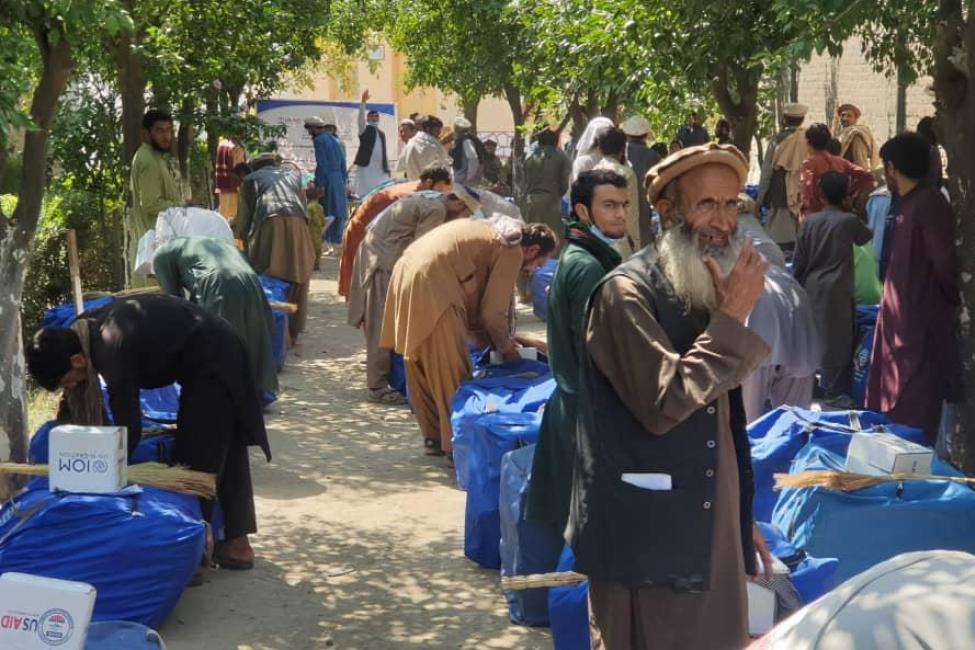-
Who we are
WHO WE AREThe International Organization for Migration (IOM) is part of the United Nations System as the leading inter-governmental organization promoting since 1951 humane and orderly migration for the benefit of all, with 175 member states and a presence in 171 countries.
-
Our Work
Our WorkAs the leading inter-governmental organization promoting since 1951 humane and orderly migration, IOM plays a key role to support the achievement of the 2030 Agenda through different areas of intervention that connect both humanitarian assistance and sustainable development.
What We Do
What We Do
Partnerships
Partnerships
Highlights
Highlights
- Where we work
-
Take Action
Take Action
Work with us
Work with us
Get involved
Get involved
- Data and Research
- 2030 Agenda
IOM Expands Humanitarian and Protection Assistance in Afghanistan, Continues Community Development Work
Kabul – The International Organization for Migration (IOM) continues to expand its relief operations across Afghanistan in response to mounting, complex humanitarian needs fuelled by drought and conflict while reengaging established livelihood, community development and infrastructure projects.
IOM’s humanitarian response includes frontline emergency shelter for vulnerable internally displaced persons (IDPs), protection services including family reunification, and health services delivered from clinics and through mobile teams, who travel to communities to deliver primary and reproductive healthcare, mental health services, and COVID-19 Rapid Response.
IOM is coordinating with its partners across the country to ensure joint assessments and distribution of critical aid continue for vulnerable populations, more than 5.5 million of whom are internally displaced.
“It is critical to ensure the continuity of humanitarian operations for the millions of Afghans affected by conflict, COVID-19 and natural disasters including drought, particularly as winter approaches,” said IOM Afghanistan Chief of Mission, Stuart Simpson.
“As part of our commitment to stay in Afghanistan we continue to advocate for unimpeded access, including for our female staff, to all those displaced, many of whom are turning to desperate measures, borrowing money and selling possessions just to feed their families."
A call centre to support IOM's Displacement Tracking Matrix (DTM), which monitors population displacement, is collecting the latest information on those forced from their homes by drought and conflict.
Data collected from recent interviews with more than 500 people in nine provinces reveals the extent to which ordinary Afghans are struggling to cope; 85 per cent report borrowing food or relying on friends and family while significant numbers of adults (29 per cent) are going hungry so their children can eat; 65 per cent are borrowing money while 43 per cent have sold land to feed their families.
IOM has provided emergency shelter and core relief items, including blankets, kitchen sets and construction tools, to more than 5,000 people in Kabul, Ghazni and other districts this month. In the first week of September alone, basic health services including psycho-social and reproductive health services reached more than 2,500 people in Herat, Kandahar and Nimroz provinces.
IOM’s expanding assessments reveal that food, cash and drinking water, along with medical services, are priority needs for the almost 600,000 Afghans displaced since the start of the year.
Even as pressing humanitarian needs are identified, IOM has resumed community development activities in six provinces, constructing school buildings and irrigation and other water supply systems to mitigate the effects of drought. The long-term investment in small business start-ups is on-going.
"After years working on grassroots community stabilization, economic and skills development programming, and community-focused, integrated approaches towards reintegration, we are also acutely aware of the need to maintain the development gains that have been made over the last decades,” Simpson said.
More than 850,000 people have returned to the country so far this year and return flows are continuing, despite uncertainty.
Since the end of August, more than 1,900 vulnerable undocumented returnees received emergency humanitarian assistance at the main border crossing points with Pakistan and the Islamic Republic of Iran, and tens of thousands of people – including many entering Afghanistan – have been screened for COVID-19 in an effort to control the spread of the pandemic.
IOM’s financial requirements under the joint Humanitarian Response Plan (HRP) for Afghanistan in 2021 total USD 108.5 million, targeting 1.9 million among the most vulnerable people including those on the move. This includes a USD 24 million appeal released in August which outlines immediate funding requirements in order to respond to pressing humanitarian needs.
For more information, please contact:
In Islamabad: IOM Spokesperson, Safa Msehli, Email: smsehli@iom.int
In Bangkok: Regional Spokesperson, Itayi Viriri, Email: iviriri@iom.int






